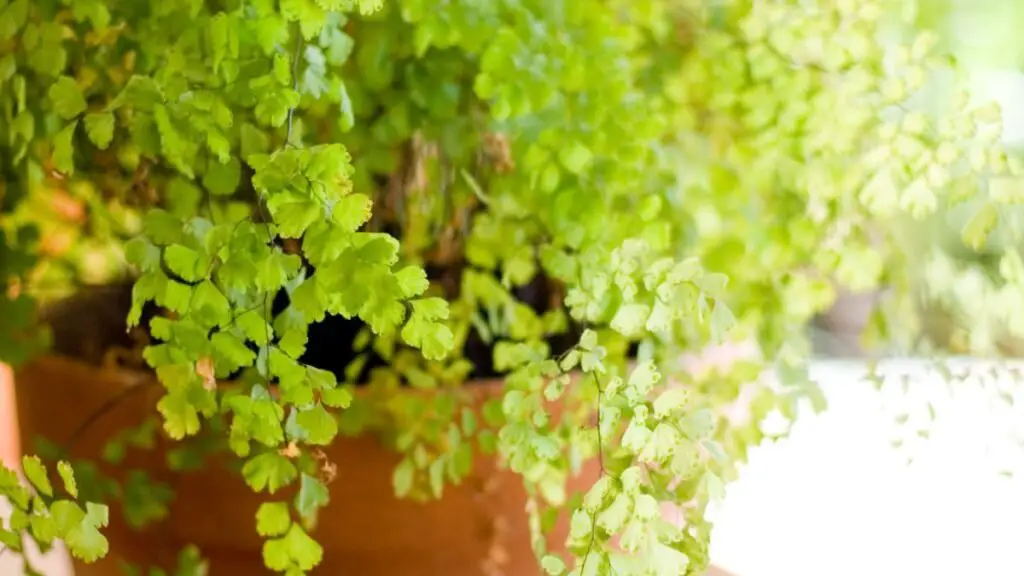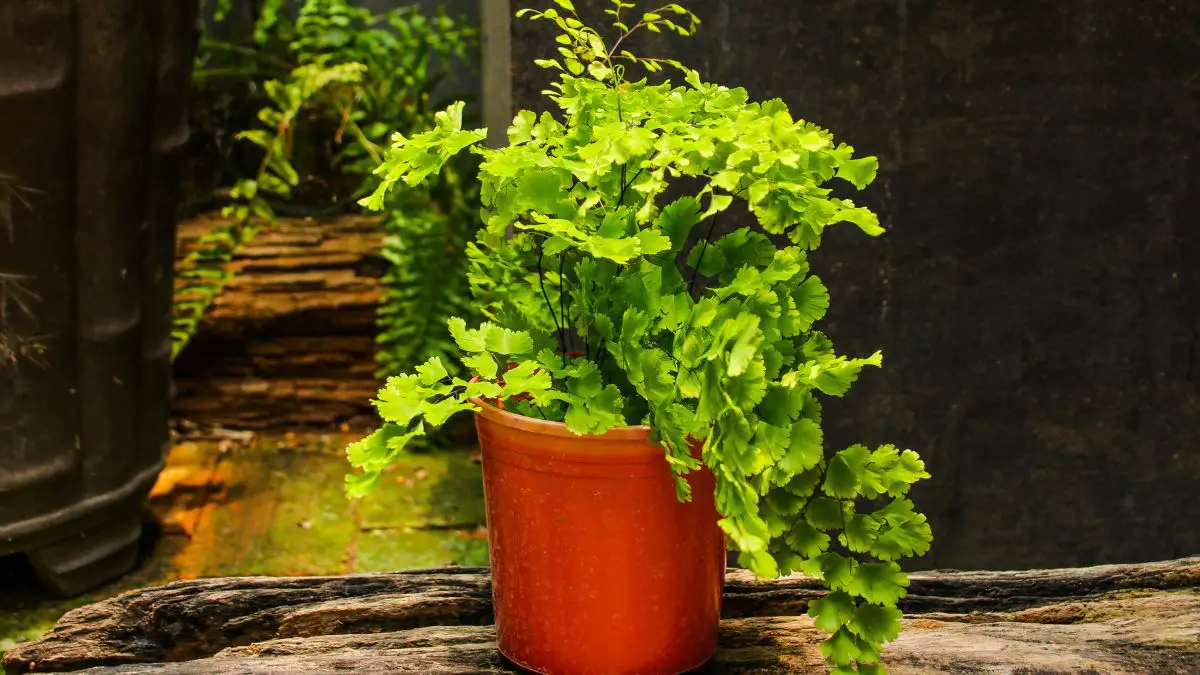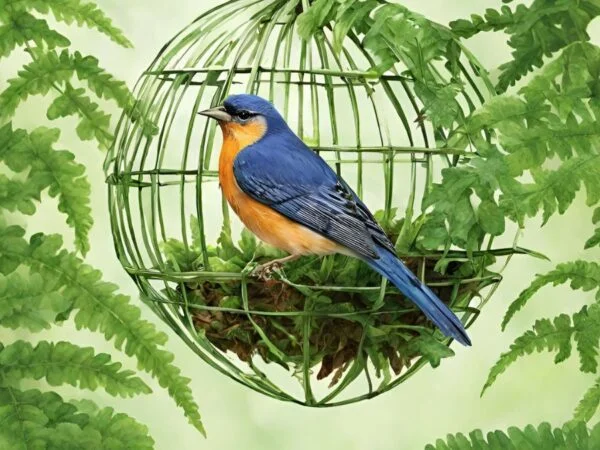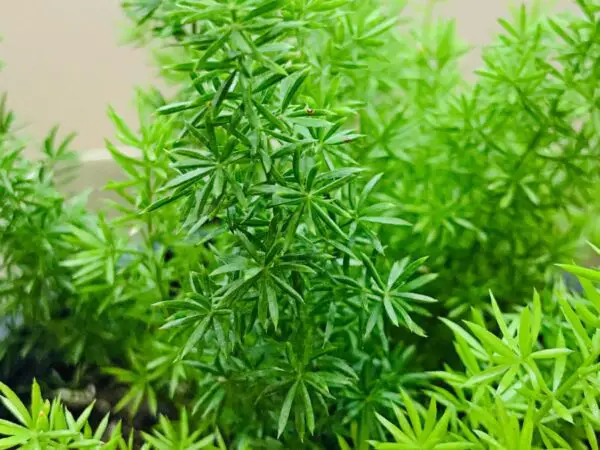Maidenhair ferns, also known as maidenhairs, are delicate frond plants that require specific care, such as moist soil, to thrive in an indoor garden. In this guide, we'll explore how to care for maidenhair ferns, ensuring they stay healthy and vibrant in your home indoor garden.
Maidenhair ferns thrive indoors in high humidity, indirect light, and consistently moist soil. Place them in a location with filtered sunlight, such as near a north-facing window. Keep the soil evenly moist, but avoid overwatering, as this can lead to root rot. Mist the leaves regularly to maintain humidity, as these maidenhairs ferns prefer humid environments. Additionally, ensure good airflow around the plant to prevent fungal diseases. Fertilize sparingly during the growing season to support healthy growth. With proper care, your maidenhair fern will reward you with its graceful, airy foliage, adding beauty to your indoor space.
If you're new to caring for maidenhair ferns, don't worry! There's much more to learn about these fascinating plants, from propagation techniques to troubleshooting common issues. Explore our comprehensive guides and tips to become a maidenhair fern expert in no time.
Key Takeaways
- **Regularly check the moisture level of the soil to ensure it stays consistently damp but not waterlogged.
- **Place your maidenhair fern in a location with indirect sunlight and high humidity to mimic its natural habitat.
- **Monitor for common issues like browning fronds or pests, and take prompt action to address them.
- **Consider using a humidifier or pebble tray to increase humidity levels for a happier fern.
- **Experiment with advanced care techniques like division or repotting for optimal growth.
- **Adjust your care routine based on seasonal changes to support the fern's health and well-being.
Maidenhair Fern Overview
Species Varieties
Maidenhair ferns come in different species with unique characteristics. Consider variations in leaf shape and size when choosing a variety. Specific care requirements vary for each maidenhair fern species.
Growth Habits
Understand the growth patterns of maidenhair ferns for optimal care. Monitor the growth rate to adjust watering and fertilizing schedules accordingly. Recognize how growth habits can indicate the plant's overall health.
Why Choose Maidenhair
Discover the benefits of having a maidenhair fern as a houseplant. Learn about the aesthetic appeal and air-purifying qualities that maidenhair ferns offer. Understand how these delicate foliage plants can enhance indoor spaces.
Essential Care Needs
Watering Practices
Implement a consistent watering routine to maintain soil moisture levels. Adjust the frequency based on plant response to prevent overwatering. Use gentle watering techniques to keep the maidenhair fern hydrated without waterlogging.
Light Requirements
Place the plant in indirect bright light to thrive. Avoid direct sunlight exposure to prevent leaf damage. Rotate periodically for even light exposure on all sides.
Soil and Potting
Choose a well-draining potting mix for healthy root growth. Repot when roots outgrow the current container. Opt for a plastic pot to retain soil moisture levels.
Temperature and Humidity
Maintain a consistent temperature range for optimal growth. Provide adequate humidity by regular misting. Avoid drafts or heating vents to prevent temperature fluctuations.
Troubleshooting Common Issues
Browning Leaves
Maidenhair fern's leaves may turn brown due to underwatering or low humidity. Trim brown fronds using clean scissors to promote new growth. Adjust watering and humidity levels to prevent further browning.
Yellowing Fronds
Address yellowing fronds promptly to prevent potential plant stress. Check for overwatering or nutrient deficiencies as common causes of yellowing. Trim yellow fronds to encourage healthy growth.
Leaf Drop
Investigate reasons behind leaf drop, including environmental stressors. Monitor changes in watering, light, or temperature triggering leaf shedding. Adjust care practices to stabilize the plant and reduce leaf drop occurrences.
Curling Fronds
Determine factors leading to frond curling, such as inadequate humidity. Increase misting frequency or relocate the plant to a more humid environment. Inspect for pests or diseases causing the fronds to curl.
Enhancing Fern Happiness

Pruning Techniques
To keep your maidenhair fern healthy, use sharp, clean scissors to trim any dead or damaged fronds. This helps the plant focus its energy on new growth. Prune selectively to maintain the fern's natural shape and avoid excessive pruning, which can stress the plant.
Repotting Tips
Understanding when to repot your maidenhair fern is crucial. Look for signs of being rootbound such as roots circling the pot's edges. When repotting, choose a slightly larger pot with good drainage to prevent waterlogging. Refresh the potting mix during repotting to provide fresh nutrients for optimal growth.
Fertilizing Schedule
Establishing a consistent fertilizing routine is key for your maidenhair fern's health. During active growing seasons, fertilize monthly using a balanced liquid fertilizer. This supports the plant's nutritional needs without causing nutrient imbalances or potential damage from over-fertilization.
Advanced Care Techniques
Propagation Methods
Maidenhair ferns can be propagated through division or spore propagation. Division involves separating the plant into smaller sections, each with roots attached. Spore propagation requires patience as it involves planting spores on a suitable medium and waiting for them to develop into new plants.
Creating a suitable environment is crucial for successful propagation. Ensure the humidity levels are high, and the soil is well-draining yet moisture-retentive. Place the new plants in indirect light to promote healthy growth.
Monitor the propagation process closely by checking for any signs of stress or disease. Adjust watering and lighting conditions as needed to support the young plants' development.
Pest Management
Common pests that can affect maidenhair ferns include spider mites and aphids. These pests can damage the delicate foliage of the fern if left unchecked.
Using natural remedies like neem oil or insecticidal soap can help control pest infestations without harming the plant. Regularly spraying the foliage with these solutions can prevent pests from spreading.
Inspecting the plant regularly is essential to catch any early signs of pest presence. Look out for yellowing leaves, webbing on the foliage, or tiny insects crawling on the plant. Early intervention can prevent severe damage to your maidenhair fern.
Seasonal Care Guide
Spring and Summer Care
During spring and summer, adjust the watering and fertilizing schedule to support the maidenhair fern's growth. Ensure adequate ventilation and humidity levels to promote healthy foliage. Keep an eye out for any signs of stress caused by seasonal changes.
In these seasons, it is essential to adapt your care routine to meet the plant's increased needs. Consider creating a consistent watering schedule and providing extra nutrients when necessary. Remember to maintain a suitable environment with proper air circulation and humidity levels.
Fall and Winter Care
As fall approaches, start reducing the frequency of watering to account for the maidenhair fern's dormant period. Be cautious not to overwater during winter, as this can lead to root rot. Shield the plant from cold drafts and abrupt temperature fluctuations that can harm its delicate leaves.
In fall and winter, ensure you make appropriate adjustments to your care regimen. This includes modifying lighting conditions due to shorter daylight hours in these seasons. Find a balance between light exposure and darkness to help the plant thrive during its rest phase.
Problem Prevention Strategies
Humidity Control
Maintain high humidity levels by misting the maidenhair fern regularly to mimic its natural environment. Utilize a humidity tray filled with water and pebbles to increase moisture around the plant. Keep a close eye on the leaf condition as an indicator of humidity adequacy.
Adequate Lighting
Ensure the maidenhair fern is placed in an area with indirect light, avoiding direct sunlight exposure that can harm its delicate leaves. Rotate the plant periodically to ensure even light distribution and promote balanced growth. Adequate lighting is crucial for the fern's overall health and vitality.
Proper Watering
Regularly check the soil moisture level to prevent issues like underwatering or overwatering, which can be detrimental to the plant's health. When watering, ensure thorough saturation while allowing excess water to drain freely from the pot. Adjust your watering routine based on seasonal changes and specific requirements of the maidenhair fern.
Additional Tips for Success
Choosing the Right Container
When caring for maidenhair fern, it's crucial to select a pot with drainage holes to prevent waterlogging, which can lead to root rot. The size of the pot should be considered to ensure it accommodates the fern's delicate root system. Opting for a plastic pot can help retain moisture, creating an ideal environment for healthy growth.
Monitoring Growth
To ensure the optimal health and vitality of your maidenhair fern, track its growth patterns regularly. Keep an eye on the frequency of new fronds or leaf development as key indicators of growth. By observing these growth cues, you can adjust your care practices accordingly to meet the plant's specific needs and promote overall well-being.
Frequently Asked Questions
Watering Frequency
Establish a routine watering schedule to meet the maidenhair fern's moisture requirements. Check the soil moisture daily for accurate watering needs. Adjust watering frequency as per seasonal changes to support the plant's growth stages.
Light Exposure Queries
Address concerns regarding light exposure for maidenhair ferns. Provide guidance on ideal lighting conditions and risks of excessive sunlight. Offer solutions to modify light exposure levels to suit the plant's light preferences.
Signs of Stress
Identify stress indicators in maidenhair ferns, such as drooping or color changes. Investigate potential stress causes like environmental factors or care routines. Take immediate corrective actions to relieve stress and revive the plant's health.
Closing Thoughts
In caring for your maidenhair fern, you've learned the crucial elements to ensure its health and vibrancy. By understanding its needs, troubleshooting issues, and implementing advanced care techniques, you're well-equipped to foster a thriving environment for your delicate plant. Remember to refer back to the seasonal care guide, prevention strategies, and additional tips for ongoing success.
Take action now! Apply these insights to nurture your maidenhair fern effectively. Share your newfound knowledge with fellow plant enthusiasts to spread the joy of cultivating lush greenery in your living spaces.
Frequently Asked Questions
How often should I water my Maidenhair Fern?
Water your Maidenhair Fern when the top inch of soil feels dry to the touch. Typically, aim to water it 2-3 times a week, but adjust based on environmental conditions like temperature and humidity.
Can Maidenhair Fern tolerate direct sunlight?
Maidenhair Ferns prefer bright, indirect light but can tolerate some morning sunlight. Avoid exposing them to harsh afternoon sun as it can scorch their delicate fronds.
How do I increase humidity for my Maidenhair Fern?
To boost humidity, mist the fern regularly with room temperature water, place a humidifier nearby, or set the pot on a pebble tray filled with water. Avoid placing near drafts or heating vents.
Should I fertilize my Maidenhair Fern?
Fertilize your Maidenhair Fern sparingly during the growing season (spring and summer) using a diluted liquid houseplant fertilizer. Apply every 4-6 weeks to avoid over-fertilization which can harm the plant.
How do I propagate my Maidenhair Fern?
Propagate your Maidenhair Fern by dividing the plant at its roots during repotting. Gently separate the root ball into sections ensuring each new plant has both roots and fronds. Plant in well-draining soil and keep moist until established.
Image Source: Paid image from CANVA





